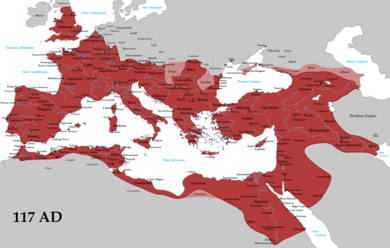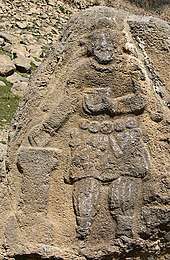Vologases III of Parthia
Vologases III (Parthian: 𐭅𐭋𐭂𐭔 Walagash) was king of the Parthian Empire from 110 to 147. He was the son and successor of Pacorus II (r. 78–110).
| Vologases III 𐭅𐭋𐭂𐭔 | |
|---|---|
%2C_Seleucia_mint.jpg) Coin of Vologases III, minted at Seleucia in 121/2 | |
| King of the Parthian Empire | |
| Reign | 110 – 147 |
| Predecessor | Pacorus II (predecessor) Osroes I (rival king) Mithridates V (rival king) |
| Successor | Vologases IV |
| Died | 147 |
| Dynasty | Arsacid dynasty |
| Father | Pacorus II |
| Religion | Zoroastrianism |
Vologases III's reign was marked by civil strife and warfare. At his ascension, he had to deal with the usurper Osroes I (r. 109–129), who managed to seize the western part of the empire, which left Vologases III in control of its eastern parts. After Osroes I violated the Treaty of Rhandeia with the Romans by appointing Parthamasiris as the king of Armenia in 113, the Roman emperor Trajan (r. 98–117) invaded the Parthian lands, briefly seizing the Parthian cities of Seleucia and Ctesiphon and reaching as far as the Persian Gulf. These gains were short-lived; all the Roman gains had been lost after Trajan's death in 117. Vologases III, whose eastern domains were untouched, took advantage of the weakened state of Osroes I to regain lost territory, and finally defeated him in 129. Another contender named Mithridates V shortly appeared afterwards, but was also defeated by Vologases III, in 140.
Vologases III had to face an invasion by the nomadic Alans from 134 to 136, while in the east, he sought to increase the political and military actions as a response to the enlargement of the Kushan Empire. Under the Roman emperor Antoninus Pius (r. 138–161), disturbance once occurred in Armenia due to the Romans appointing a new king in Armenia. Vologases III, however, did not protest, either due to not being powerful enough, or possibly because he did not want to put the thriving long-distance trade in jeopardy, from which the Parthian state was gaining hefty income from. Vologases III was succeeded by Mithridates V's son Vologases IV in 147.
Name
Vologases is the Greek and Latin form of the Parthian Walagaš (𐭅𐭋𐭂𐭔). The name is also attested in New Persian as Balāsh and Middle Persian as Wardākhsh (also spelled Walākhsh). The etymology of the name is unclear, although Ferdinand Justi proposes that Walagaš, the first form of the name, is a compound of words "strength" (varəda), and "handsome" (gaš or geš in Modern Persian).[1]
Reign

Vologases III was a son of Pacorus II (r. 78–110).[2] During the last years of Pacorus' reign, Vologases III co-ruled with him.[2] A Parthian contender named Osroes I appeared in 109.[3] Pacorus died in the same year, and was succeeded by Vologases III, who continued his fathers struggle with Osroes I over the Parthian crown.[2] Osroes I managed to seize the western part of the empire, including Mesopotamia, while Vologases III ruled in the east.[2][4] Osroes I violated the Treaty of Rhandeia with the Romans by deposing Vologases III's brother Axidares and appointing the latters brother Parthamasiris as the king of Armenia in 113.[2][5] This gave the Roman emperor Trajan (r. 98–117) the pretext to invade the Parthian domain and take advantage of the civil war ongoing between Vologases III and Osroes I.[2][4] Trajan conquered Armenia and turned it into a Roman province in 114.[5] In 116, Trajan captured Seleucia and Ctesiphon, the capitals of the Parthians.[6] Trajan even reached as far as the Persian Gulf, where he forced the Parthian vassal ruler of Characene, Attambelos VII, to pay tribute.[7][8] Fearing a revolt by the Parthians, Trajan installed Osroes I's son Parthamaspates on the throne at Ctesiphon.[7][9]

However, these gains were short-lived; revolts occurred in all the conquered territories, with the Babylonians and Jews pushing the Romans out of Mesopotamia, and the Armenians causing trouble under the leadership of a certain Sanatruk.[10] After Trajans death in 117, the Parthians removed Parthamaspates from the throne and reinstated Osroes I.[7] Trajan's successor, Hadrian (r. 117–138) renounced the remnants of Trajan's conquests in the east, and acknowledged the Treaty of Rhandeia, with the Parthian prince Vologases becoming the new king of Armenia.[11] The weakened state of the western part of the Parthian Empire gave Vologases III—whose eastern domains were untouched—the opportunity to regain lost territory seized by Osroes I.[4]
Vologases III finally managed to remove Osroes I from power in 129.[3][12] However, shortly afterwards, a new contender named Mithridates V appeared.[13][12] Vologases III also faced new challenges in other places; in 134, the king of Iberia, Pharasmanes II (r. 117–138) caused the nomadic Alans to invade the domains of the Parthians and Romans.[12][1] They reached as far as Caucasian Albania, Media, Armenia, and also Cappadocia; they were eventually repelled two years later after many obstacles and heavy economic costs.[1] In the east, Vologases III sought to increase the political and military actions as a response to the enlargement of the Kushan Empire.[3] Vologases III defeated and deposed Mithridates V in 140.[13][12]
Under Hadrian's successor, Antoninus Pius (r. 138–161), a disturbance occurred after the Romans appointed a new king in Armenia.[1] Vologases III, however, did not protest, either due to not being powerful enough, or possibly because he did not want to put the thriving long-distance trade in jeopardy, from which the Parthian state was gaining hefty income from.[1] Vologases III was succeeded by Mithridates V's son Vologases IV in 147.[3][4]
Coinage and Rock reliefs

Under Pacorus II, the usage of the image of the Greek goddess Tyche on the reverse of the Parthian coins became more regular than that of the seated king with a bow, specifically on the coin mints from Ecbatana.[14] This was reversed under Vologases III.[14] Rarely, a fire temple is depicted on the reverse of his coins.[15] On the obverse of his coins is a portrait of him using the same tiara as his father.[16] A rock relief at Behistun portrays an Parthian monarch, most likely Vologases III.[15]
References
- Chaumont & Schippmann 1988, pp. 574–580.
- Dąbrowa 2012, p. 176.
- Dąbrowa 2012, pp. 176, 391.
- Gregoratti 2017, p. 133.
- Chaumont 1986, pp. 418–438.
- Dąbrowa 2012, p. 176; Gregoratti 2017, p. 133; Kettenhofen 2004
- Kettenhofen 2004.
- Hansman 1991, pp. 363–365.
- Bivar 1983, p. 91.
- Gregoratti 2017, p. 133; Chaumont 1986, pp. 418–438; Dąbrowa 2012, p. 176
- Badian 2002, p. 458; Chaumont 1986, pp. 418–438; Dąbrowa 2012, p. 176
- Kia 2016, p. 203.
- Dąbrowa 2012, p. 391.
- Rezakhani 2013, p. 771.
- Olbrycht 2016, p. 96.
- Olbrycht 1997, p. 33.
Sources
- Badian, Ernst (2002). "Hadrian". Encyclopaedia Iranica, Vol. XI, Fasc. 4. p. 458.CS1 maint: ref=harv (link)
- Bivar, A.D.H. (1983). "The Political History of Iran Under the Arsacids". In Yarshater, Ehsan (ed.). The Cambridge History of Iran, Volume 3(1): The Seleucid, Parthian and Sasanian Periods. Cambridge: Cambridge University Press. pp. 21–99. ISBN 0-521-20092-X.
- Chaumont, M. L. (1986). "Armenia and Iran ii. The pre-Islamic period". Encyclopaedia Iranica, Vol. II, Fasc. 4. pp. 418–438.CS1 maint: ref=harv (link)
- Chaumont, M. L.; Schippmann, K. (1988). "Balāš". Encyclopaedia Iranica, Vol. III, Fasc. 6. pp. 574–580.CS1 maint: ref=harv (link)
- Dąbrowa, Edward (2012). "The Arsacid Empire". In Daryaee, Touraj (ed.). The Oxford Handbook of Iranian History. Oxford University Press. pp. 1–432. ISBN 978-0-19-987575-7. Archived from the original on 2019-01-01. Retrieved 2019-01-13.CS1 maint: ref=harv (link)
- Gregoratti, Leonardo (2017). "The Arsacid Empire". In Daryaee, Touraj (ed.). King of the Seven Climes: A History of the Ancient Iranian World (3000 BCE - 651 CE). UCI Jordan Center for Persian Studies. pp. 1–236. ISBN 9780692864401.CS1 maint: ref=harv (link)
- Hansman, John (1991). "Characene and Charax". Encyclopaedia Iranica, Vol. V, Fasc. 4. pp. 363–365.CS1 maint: ref=harv (link)
- Kettenhofen, Erich (2004). "Trajan". Encyclopaedia Iranica. pp. 418–438.CS1 maint: ref=harv (link)
- Kia, Mehrdad (2016). The Persian Empire: A Historical Encyclopedia. ABC-CLIO. ISBN 978-1610693912.CS1 maint: ref=harv (link) (2 volumes)
- Olbrycht, Marek Jan (1997). "Parthian King's tiara - Numismatic evidence and some aspects of Arsacid political ideology". 2: 27–61. Cite journal requires
|journal=(help)CS1 maint: ref=harv (link) - Olbrycht, Marek Jan (2016). "The Sacral Kingship of the early Arsacids. I. Fire Cult and Kingly Glory": 91–106. Cite journal requires
|journal=(help)CS1 maint: ref=harv (link) - Rezakhani, Khodadad (2013). "Arsacid, Elymaean, and Persid Coinage". In Potts, Daniel T. (ed.). The Oxford Handbook of Ancient Iran. Oxford University Press. ISBN 978-0199733309.CS1 maint: ref=harv (link)
Vologases III of Parthia | ||
| Preceded by Pacorus II (predecessor) Osroes I (rival king) Mithridates V (rival king) |
King of the Parthian Empire 110–147 |
Succeeded by Vologases IV |